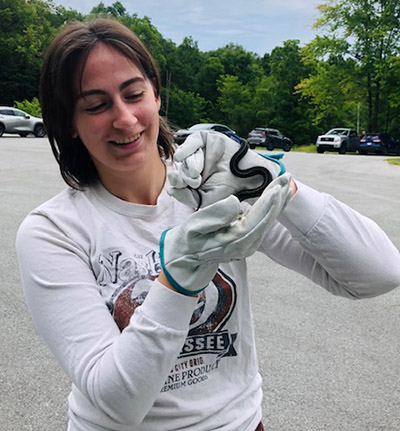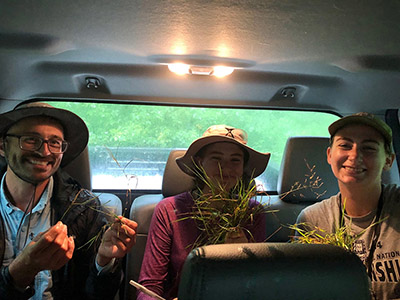FNR Field Report: Amber Laughner
Students from Purdue Forestry and Natural Resources took their classroom knowledge to the field for summer internships and paid positions across the country, gaining valuable experience, hands-on training and career guidance. The FNR Field Reports series offers updates from those individuals as their positions draw to a close.
draw to a close.
Senior forestry major Amber Laughner was a stewardship intern at Shirley Heinze Land Trust in northwest Indiana. In that role, she assisted with invasive species removal, worked on plot sampling and transect sampling projects and performed various field work on the preserves.
The Chesterton, Indiana, native, whose studies have a forest management concentration, gained knowledge about the land and the natural resources field in general through this position, which she found through a Shirley Heinze Land Trust Instagram post.
“I learned a lot about what qualifies land as a remnant habitat, what to look for in identifying a remnant habitat, and what implications that has for management, ecosystem services, and wildlife,” Laughner said. “I also learned about many new plant species that are important to boreal forests, wetlands, and prairies in northwest Indiana. Additionally, we were given the opportunity to read some of Shirley Heinze's management plans to get a feel for what these documents should look like. By interacting with the staff of a small organization every day, I also learned a lot about what it takes for a nonprofit to manage large areas of land: meeting the most important goals for each season while staying within budget, engaged in the community, and organized as a business.”
As a stewardship intern, Amber’s duties included spraying for invasives, collecting seeds, and completing monitoring data using plot sampling for a future project. In addition, every Friday all of the interns participated in "student experience" days, where they toured a new Shirley Heinze preserve or did an activity and met professionals from varying natural resources fields.
“One of my favorite parts of the job was interacting with and working towards improving high-quality habitats, one of which is globally rare (dune and swale),” Laughner shared. “This allowed me to see a lot of very cool plants and animals. Another of my favorite parts was getting to work with experts in the field. Every day I left with more new facts than I could possibly remember, which was really valuable to my learning experience.
with more new facts than I could possibly remember, which was really valuable to my learning experience.
“There were two very challenging aspects of the job for me. The first was the physical labor in environments that were difficult to walk through, in very hot weather, either carrying backpack sprayers full of chemicals or several tools that we needed for monitoring. The other was working with people who seemed to have a never-ending knowledge of everything in the field, which I found to be upsetting when I compared it to my knowledge. However, I learned to be appreciative that I was learning from these people every day.”
Laughner also was able to apply some knowledge and skills from her FNR courses in the role.
“My FNR studies helped me greatly in this job,” she said. “My previous experience with quadrat sampling, my dendrology knowledge and my comfort with being outside in the field proved to be very useful, along with my practice in writing lab reports.”
Amber said something she will remember was the final presentation that all of the interns did at the end of the summer.
“Shirley Heinze rented out a nice conference room with a view of Lake Michigan and invited all the professionals we met on our Friday student experiences. Each intern then gave a 10-minute presentation about what they did and learned over the summer,” Laughner recalled. “Not only did I enjoy learning more about what other interns worked on, but I really appreciated the opportunity to connect further with professionals in related fields. I was able to talk with two national park employees who offered me advice on how to enter the National Park Service. I also learned about so many nature preserves in the area that I never would have known about otherwise, allowing me to see fascinating hidden parts of the NW Indiana ecosystem.”
professionals in related fields. I was able to talk with two national park employees who offered me advice on how to enter the National Park Service. I also learned about so many nature preserves in the area that I never would have known about otherwise, allowing me to see fascinating hidden parts of the NW Indiana ecosystem.”
All told, her summer as a stewardship intern was helpful for Laughner in determining her career path.
“I would not say my position changed my career goals, but it helped me hone in on them,” she shared. “I found the work to be very fulfilling and it let me know that I can see myself working in ecological restoration for longer. Through my experience and the connections I made at this internship, I feel that I am more suited for a position with the National Park Service, which I hope to use as a starting point for the rest of my career after college.”
Laughner has spent the past two summers working as a laborer for the Indiana Dunes State Park. She is currently in her second semester completing an independent study with Megan Gunn, assisting with Illinois-Indiana Sea Grant projects, including planning and executing a water quality field trip for environmental science students at Portage High School last year.
In FNR, she is a member of the Student Chapter of Environmental Education.
 A collage of images from Amber Laughner's summer internship at Shirley Heinze Land Trust. Top row (Left to right): Amber with her co-worker Chloe and Doug Botka, an ecologist at Shirley Heinze Land Trust; a blue flag iris at Ambler Flatwoods; a compass plant (Silphium laciniatum) at Cressmoor Prairie; ghost pipes at Lydick Bog; an emerging cicada nymph; club moss at Ambler Flatwoods. Row 2: A field of Lizard's tail (Saururus cernuus) at Father Basil Moreau; Great angelica at Beverly Shores; Lesser Purple Fringed Orchid (Platanthera psycodes) at Indiana Dunes State Park; Oblong-leaved Sundew (Drosera intermedia); Pinesap (Monotropa hypopitys) at Indiana Dunes State Park; Great Marsh at Indiana Dunes State Park. Row 3: Succession Trail at Indiana Dunes National Park; striped wintergreen at Ambler Flatwoods; bladderwort at Beverly Shores; a spicebush silkmoth (Callosamia promethea); a box turtle at Ambler Flatwoods.
A collage of images from Amber Laughner's summer internship at Shirley Heinze Land Trust. Top row (Left to right): Amber with her co-worker Chloe and Doug Botka, an ecologist at Shirley Heinze Land Trust; a blue flag iris at Ambler Flatwoods; a compass plant (Silphium laciniatum) at Cressmoor Prairie; ghost pipes at Lydick Bog; an emerging cicada nymph; club moss at Ambler Flatwoods. Row 2: A field of Lizard's tail (Saururus cernuus) at Father Basil Moreau; Great angelica at Beverly Shores; Lesser Purple Fringed Orchid (Platanthera psycodes) at Indiana Dunes State Park; Oblong-leaved Sundew (Drosera intermedia); Pinesap (Monotropa hypopitys) at Indiana Dunes State Park; Great Marsh at Indiana Dunes State Park. Row 3: Succession Trail at Indiana Dunes National Park; striped wintergreen at Ambler Flatwoods; bladderwort at Beverly Shores; a spicebush silkmoth (Callosamia promethea); a box turtle at Ambler Flatwoods. 





